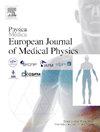Diagnostic Reference Levels in nuclear medicine for Positron Emission Tomography examinations: First Italian multicenter data collection
IF 3.3
3区 医学
Q1 RADIOLOGY, NUCLEAR MEDICINE & MEDICAL IMAGING
Physica Medica-European Journal of Medical Physics
Pub Date : 2025-04-23
DOI:10.1016/j.ejmp.2025.104984
引用次数: 0
Abstract
Introduction
Diagnostic Reference Levels (DRLs) are essential for optimizing patient protection in radiological imaging. PET/CT acquisitions are fundamental in modern nuclear medicine for diagnosis, staging and tumor response evaluation. The hybrid nature of PET/CT results in a total dose to the patient from both modalities. Therefore, it is appropriate to set and evaluate DRLs independently for each modality. While DRLs for some PET tracers are extensively described by various national and international guidelines, similarly established guidelines for the low-dose CT component are lacking.
Methods
In 2022, a multicenter collaboration was established among three Italian Hospitals to evaluate dosimetric indices for almost 13,000 PET/CT scans using various scanner technologies and tracers. The dosimetric data were classified based on the radiopharmaceuticals injected and further stratified according to scan length: Whole Body (WB), head vertex-to-feet and brain.
Results
The results for all tracers and imaging procedures evaluated are compliant with or lower than available DRLs. For some exam types, national DRLs are not currently defined and so typical values, calculated as the median of the data distribution in this study, are proposed. For the PET the typical values are proposed in terms of total and per kilogram administered activity, while for the CT they are proposed in terms of CTDIvol and DLP.
Conclusion
In line with Directive 2013/29/Euratom, these collected data could be valuable for a future review of DRLs for both PET tracers and low-dose CT component in WB studies, and for defining new DRLs for low-dose CT component in vertex-to-feet and brain studies.
正电子发射断层扫描检查的核医学诊断参考水平:首次意大利多中心数据收集
诊断参考水平(drl)对于优化放射成像患者保护至关重要。PET/CT采集是现代核医学诊断、分期和肿瘤反应评估的基础。PET/CT的混合性质导致两种方式对患者的总剂量。因此,对每种模式分别设置和评估drl是合适的。虽然各种国家和国际指南对某些PET示踪剂的drl进行了广泛描述,但缺乏针对低剂量CT组分的类似指南。方法2022年,意大利三家医院建立了多中心合作,利用各种扫描仪技术和示踪剂评估近13,000次PET/CT扫描的剂量学指标。剂量学数据根据注射的放射性药物进行分类,并根据扫描长度进一步分层:全身(WB),头顶点到脚和脑。结果所有示踪剂和影像学评估结果均符合或低于可用的drl。对于某些考试类型,目前没有定义国家drl,因此提出了典型值,作为本研究数据分布的中位数计算。对于PET的典型值是根据总和每千克给药活性提出的,而对于CT,它们是根据CTDIvol和DLP提出的。根据2013/29/Euratom指令,这些收集到的数据对于PET示踪剂和低剂量CT成分在WB研究中的drl的未来审查,以及定义低剂量CT成分在点到脚和脑研究中的新drl具有重要价值。
本文章由计算机程序翻译,如有差异,请以英文原文为准。
求助全文
约1分钟内获得全文
求助全文
来源期刊
CiteScore
6.80
自引率
14.70%
发文量
493
审稿时长
78 days
期刊介绍:
Physica Medica, European Journal of Medical Physics, publishing with Elsevier from 2007, provides an international forum for research and reviews on the following main topics:
Medical Imaging
Radiation Therapy
Radiation Protection
Measuring Systems and Signal Processing
Education and training in Medical Physics
Professional issues in Medical Physics.

 求助内容:
求助内容: 应助结果提醒方式:
应助结果提醒方式:


